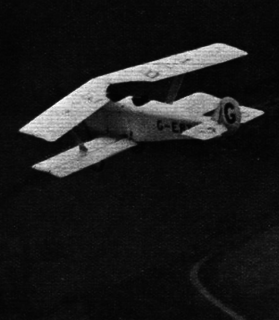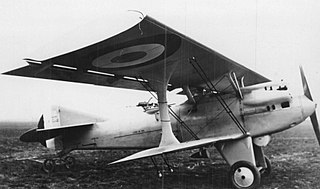
The Slingsby Type 42 Eagle was a two-seat glider designed in England from 1952.

The Parnall Imp was an unusual single-engined, two-seat British biplane built in 1927. It had a straight cantilever lower wing which supported the markedly swept upper wing. Only one was built.
The I.S.T. L-17 Masang was a two-seat, single engine, low wing monoplane aircraft designed and built in the Philippine Republic in the mid-1950s. It was intended for both touring and training.

The EoN 460 series are wooden single-seat standard class sailplanes, built in the UK in the 1960s. It did not have major competition success but some remain in use in 2017.

The Potez 37 was a two-seat, long range reconnaissance aircraft built to compete for a French government contract. It flew in mid-1930 but did not win the competition, so only two were completed.

The CNA PM.1 was a single-engine light sport and training aircraft designed and built in Italy at the start of World War II. After tests of the prototype a small production run was laid down but destroyed by bombing.
The Bréguet Br 900 Louisette was a short-span, single-seat competition sailplane built in France in the 1940s. It set some French gliding records but was unsuccessful at the international level. Only six production aircraft were built.

The Breguet 901 Mouette is a single seat French competition sailplane from the 1950s. It was the winner at both the 1954 and 1956 World Gliding Championships.

The Aviamilano F.14 Nibbio is a four-seat, single engine cabin monoplane built in Italy in the late 1950s. Only ten production aircraft were completed.

The Tachihi R-53 was amongst the first aircraft built in Japan after the relaxation of the ban imposed at the end of World War II. It is a parasol-wing, two seat, training aircraft powered by a British engine. Only one was produced.
The CVV1 Pinguino was a single seat, high performance glider designed and built in Italy in the mid-1930s, the first of a series of gliders from the Milan Polytechnic. It did not go into production.

The Coupé-Aviation JC-01 is the first of a series of very similar designs of two seat, single engine sports aircraft, amateur built from plans in France from 1976. These provided a range of engine sizes and undercarriage layouts, but total production was small.
The Aviator Shershen' is a Russian two seat biplane, sold in kit form. It first flew in 2005 and several variants have been produced, with a choice of engines.

The Speedtwin E2E Comet 1, originally named the Phillips ST1 Speedtwin, is a two-seat, twin engined aircraft designed in the UK to be capable of aerobatics and the only civil twin certified for intentional spinning. After a long development time, just two have been built.
The IIL IS-5 was a single seat, high performance sailplane designed by Iosif Șilimon and built in Romania in 1960.
The IIL IS-10 was a high-performance, single-seat glider, designed and built in Romania in the early 1960s. It was the first Romanian aircraft to use laminar flow airfoils.
The IIL IS-11 was an aerobatic, single seat glider, designed and built in Romania in 1959. It was built in small numbers.
The Landray GL.01 is a small tandem-wing, side-by-side seat sport aircraft of the Mignet Pou-du-Ciel type. Built in the mid 1970s, the single example remains active.

The Villiers XXIV or Villiers 24 CAN2 was a French army night fighter most notable as the first French military aircraft to be fitted with leading edge slats.
The Bréguet Br 902 Cinzano was a French training glider produced in the 1950s by Société anonyme des Ateliers d'aviation Louis Bréguet











